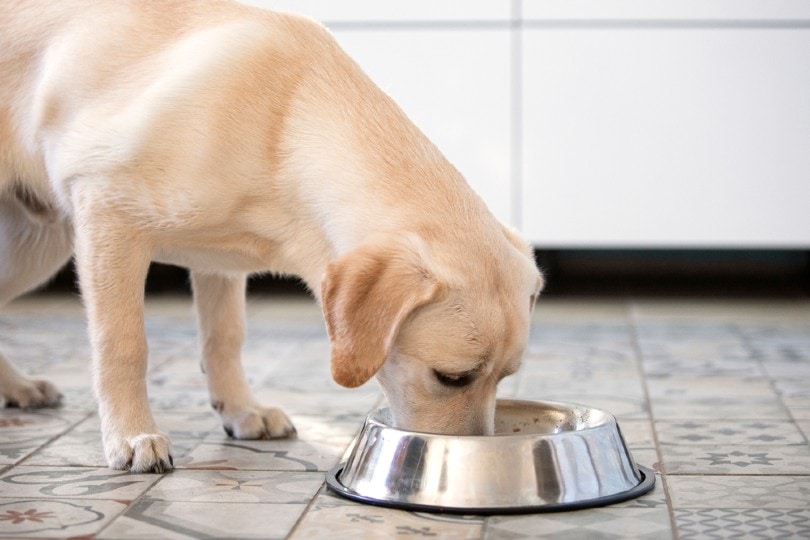Dogs are omnivores, and they can eat plant—and animal-based ingredients. In the wild, they hunt small animals individually, and in packs, they work together to take down larger animals. However, they also eat plants, including fruit and vegetables.
Ham, made from pigs, is an animal-based food, but it is recommended that we do not feed ham to pet dogs. Not only does most commercially packaged ham contain large amounts of sodium, but it is also a very fatty meat compared to other protein sources. It is also quite rich, which can lead to gastrointestinal issues.
It isn’t considered toxic, so if your dog has eaten a few pieces of ham, they should be fine, although it may lead to diarrhea or vomiting.

Dog Diet
Most commercial foods, whether wet or dry, contain a combination of vegetables, meat, and other ingredients. Complete and balanced dog food meets all of the dietary and nutritional requirements of a dog, including an appropriate amount of protein as well as all the required fats, vitamins, and minerals to ensure a healthy dog. There are benefits to dry and wet foods.
Dry food has a longer shelf life than wet food after it’s opened. It also causes less mess, but it does not contain as much moisture, and you will need to make sure your dog gets enough fresh water. Some dogs do not find dry food as palatable or appealing as they find wet food.
Wet food is more expensive than dry food, but many pups prefer it. It is possible to feed a combination of wet and dry food, either at each meal or over a day. Chicken, turkey, lamb, and beef are the most common meats used in commercial foods, which begs the question of why pork or ham isn’t used more often.

Can Dogs Eat Ham?
If your dog has eaten a small amount of ham, they should be fine because ham is not considered toxic to dogs. However, if they eat several pieces, vomiting and diarrhea may occur for a day or two. You can speak to your vet if your dog consumed several pieces or continues to have digestive issues.
If you need to speak with a vet but can't get to one, head over to PangoVet. It's our online service where you can talk to a vet online and get the advice you need for your pet — all at an affordable price!
The Pitfalls of Ham
Generally, you should not intentionally feed ham to your dog. When people talk about ham, they usually refer to the processed ham you can buy in stores. Processed foods are unhealthy and potentially dangerous for dogs because of the following reasons:
- Fatty Meat – Ham has more fat compared to other meats. When dogs eat too much fatty food, it can lead to weight gain and pancreatitis. Being overweight is as dangerous for dogs as it is for people, and obesity can lead to diabetes, joint problems, and other health conditions.
- Processed Ham Additives—Most packaged ham is highly processed and contains high levels of salt and additional additives. Some of these additives may be toxic to dogs. Garlic and onions, for example, are toxic to dogs. Even without these toxic ingredients, too much salt can cause short-term and long-term problems. Initially, it can cause dehydration and may, over time, lead to kidney disease and hypertension.

The 3 Tips for a Better Diet for Your Dog
Consuming nutritious food is vital to a dog’s health. Feeding too much or too little of certain foods can cause problems, so you must check the label and ingredients, including nutritional values, rather than buying food according to the marketing on the package. You also need to consider any other sources of food that your dog has access to, including the treats you feed during training.
1. Weigh Food Out
Commercial dog foods provide a guideline of how much to feed a dog, and if you don’t have any specific guidelines from a vet to follow, they are a good place to start. Remember to feed according to your dog’s weight and age. If your dog is overweight, don’t aim for their target weight immediately, but cut down in increments until you reach the desired weight.
When you start feeding a particular food, weigh the amount you give and determine how many scoops or cups it is rather than using the scoop guideline on the bag.

2. Feed Treats in Moderation
Most treats contain calories but do not meet the nutritional requirements of dogs. This means that you are feeding empty calories. Either switch to healthy treats, use praise or toys rather than treats for training, or monitor the number of treats you give and the total calories you feed. You will then need to reduce the amount of food you serve according to how many treats you feed.
3. Increase Exercise
If your dog is overweight, a diet is part of the solution, but it is important to ensure your dog gets enough exercise. This can include the gentle walk around the park you enjoy together, but you should try and find ways to introduce more vigorous exercise. Whether you throw a ball around the dog park, enroll in agility lessons, or take up trail running together, introducing exercise is a good way to prevent weight gain and control the weight of your dog.


Other Food Facts
Can Dogs Eat Ham Bones?
Generally, you should avoid feeding any cooked bones to dogs. Once cooked, the bones become brittle and are easily broken and splintered when your dog bites into them. These splinters can get caught in the digestive tract, which can prove fatal. Bones can also cause chipped teeth and other dental problems, so it is generally better to offer chewy bones rather than brittle ones as a treat.
Can Dogs Eat Cheese?
Although some dogs are lactose intolerant, many can handle small amounts of cheese and other dairy products. In fact, cheese is often used to hide tablets and medication because most dogs enjoy the flavor of the cheese and will miss the tablet that lurks within. Cheese, in moderation, can also be used as a training treat. However, you shouldn’t feed cheese regularly and avoid feeding too much of it in a single sitting. This is to combat any lactose intolerance issues your dog may have and the high amount of calories that cheese contains.
Always start with a small amount. If your dog eats it and shows no signs of intolerance or allergy, you can feed a little more next time. Avoid cheese with extra ingredients and choose a cheese that is low in salt. Again, keep cheese to a minimum as a treat or medication hider only.

Summary
Dogs can enjoy a varied diet consisting of meat, fruit, vegetables, and other ingredients because they are omnivores and can digest and process protein, vitamins, and minerals from various sources. While dog food typically contains several animal-based ingredients, ham, and pork are rarely used because they are considered fatty meats that encourage weight gain.
Processed ham is also high in salt and may contain other harmful ingredients, so it should be avoided. Instead, consider feeding plain chicken, lamb, or beef. They provide plenty of protein and are not usually as fatty as ham.
Related read:
Featured Image Credit: vikiri, Shutterstock




















2 Responses
Thank you for this information!
Hi Mike,
Thank you for reading! 🙂